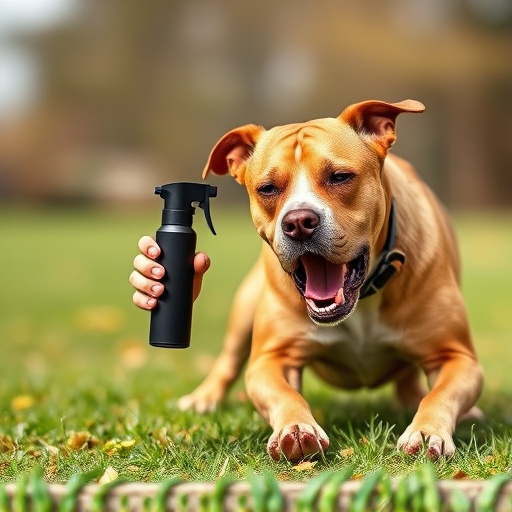Mace Dog Repellent Spray offers a non-lethal solution for mail carriers facing aggressive dogs, with a typical coverage area of 2-3 feet (0.6-0.9 meters). Approved by the US Postal Service, these sprays require proper training and understanding of local regulations. When choosing, consider property size, vegetation density, spray range, active ingredient potency, and weather resistance. Correct usage ensures temporary disorientation and deterrence, allowing carriers to complete deliveries safely.
In recent years, mace spray has emerged as a valuable tool for mail carriers facing aggressive dogs. This non-lethal solution offers an effective means of deterring canine attacks while ensuring the safety and security of postal workers. Understanding the US Postal Service’s guidelines on self-defense tools is crucial for mail carriers considering this option. This article explores the benefits, considerations, and safe use of mace dog repellent spray, focusing on key factors like coverage area and safety measures to empower carriers in navigating potentially dangerous situations.
- Understanding Mace Spray: A Non-Lethal Solution for Dog Deterrence
- US Postal Service Guidelines on Self-Defense Tools: What You Need to Know
- Factors to Consider When Choosing the Right Mace Dog Repellent Spray
- Effective Use and Safety Measures for Mace Spray in Mail Carrier Roles
Understanding Mace Spray: A Non-Lethal Solution for Dog Deterrence
Mace dog repellent spray is a non-lethal solution designed for safe and effective dog deterrence. It works by emitting a powerful stream of pepper spray that irritates a dog’s eyes, nose, and throat, temporarily disorienting them and encouraging them to leave the area. The coverage of mace dog repellent spray is crucial; it typically reaches up to 3 feet (approximately 1 meter), allowing mail carriers to protect themselves from aggressive dogs without resorting to lethal force.
This type of spray is an excellent alternative for mail carriers who encounter potentially dangerous canines, especially in areas with a high density of dogs. The fast-acting formula ensures that mail carriers can quickly create a buffer zone, providing them with the time and space needed to complete their deliveries safely. Understanding the mace dog repellent spray’s coverage area and usage instructions is vital to maximizing its effectiveness as a tool for personal protection.
US Postal Service Guidelines on Self-Defense Tools: What You Need to Know
The US Postal Service has specific guidelines regarding self-defense tools, including mace spray, to ensure safety for mail carriers and customers alike. According to their policies, mace dog repellent spray is an approved self-defense mechanism when used in accordance with state and local laws. The key considerations are the type of spray, its coverage area, and the frequency of use.
Mace dog repellent sprays must have a recommended range of 2-3 feet (0.6-0.9 meters) to be effective. This limited range ensures that the spray can be targeted without causing harm to bystanders. Additionally, carriers are advised to familiarize themselves with local regulations regarding the carrying and use of such devices, as permissions and restrictions may vary by state and municipality. Proper training on how and when to deploy the spray is crucial to ensure its effectiveness in self-defense scenarios while minimizing potential risks.
Factors to Consider When Choosing the Right Mace Dog Repellent Spray
When selecting a Mace Dog Repellent Spray, several key factors should guide your decision to ensure it’s suitable for your needs. One of the primary considerations is coverage. Different sprays offer varying ranges and amounts of spray per can, so understanding the area you need to protect is crucial. For instance, if you’re dealing with a frequent dog intrusion in a medium-sized yard, a spray with a 10-foot range might be adequate. However, for larger properties or areas with dense vegetation, opt for a spray with extended reach and more contents to ensure comprehensive protection.
Additionally, the effectiveness of the spray depends on its active ingredients and concentration. Mace typically uses capsaicin, the compound responsible for the heat sensation in chili peppers, as its main ingredient. The potency of this ingredient varies among products, affecting how well it deters dogs. Reading labels carefully to understand the strength and any additional features, such as weather resistance or night-time visibility, will help you make an informed choice.
Effective Use and Safety Measures for Mace Spray in Mail Carrier Roles
Mail carriers now have a powerful tool at their disposal to protect themselves while on route – mace spray. This non-lethal self-defence option has gained approval for use in many areas, offering a safe and effective solution to potential threats. When used appropriately, mace dog repellent spray can create a valuable buffer zone, providing mail carriers with precious time to escape or call for help during dangerous encounters.
The key to successful deployment lies in understanding the spray’s coverage and effectiveness. Mace dog repellent sprays are designed to disrupt an attacker’s vision and breathing, temporarily incapacitating them long enough for the carrier to retreat to safety. With proper training, mail carriers can learn to target specific areas like eyes, nose, and throat, maximising the impact of each spray burst while minimising collateral damage or harm to bystanders. Regular practice and adherence to safety guidelines are essential to ensure these powerful tools remain a reliable defence mechanism in their daily routes.
The US Postal Service’s approval of mace spray as a self-defense tool for mail carriers is a significant step towards ensuring their safety. Understanding the guidelines, choosing the right mace dog repellent spray with adequate coverage, and learning effective use and safety measures are essential for mail carriers to protect themselves in potentially dangerous situations. This conclusion highlights the importance of these factors in maximizing the benefits of mace spray while adhering to postal service regulations.
